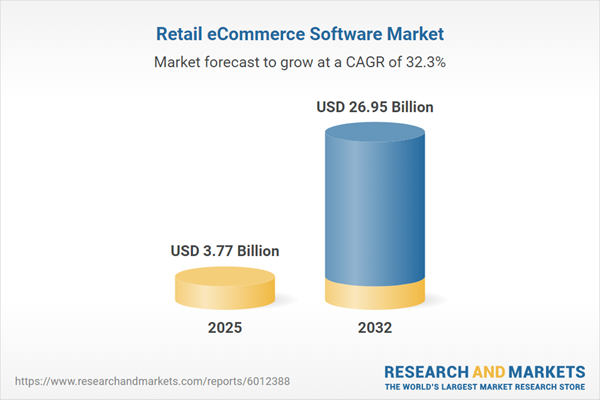Speak directly to the analyst to clarify any post sales queries you may have.
The retail eCommerce software market is rapidly transforming digital commerce, enabling organizations to improve agility and adapt to new customer expectations. Senior decision-makers increasingly adopt advanced software platforms to ensure competitive advantage and sustained market relevance.
Market Snapshot: Retail eCommerce Software Market Growth
The retail eCommerce software market is projected to expand steadily, with substantial increases in market value expected from 2024 onward. This growth is driven by elevated demand for cloud-based technology suites, advanced analytics, and integrated commerce platforms supporting enterprise transformation. Many organizations are modernizing workflows, scaling automation, and investing in digital strategies designed for operational efficiency. Senior leaders focus on seamless omnichannel customer engagement and technology scalability, which foster stronger positioning in a competitive landscape. A continuously evolving regulatory environment and heightened emphasis on resilient infrastructure sustain ongoing innovation and readiness for industry change.
Scope & Segmentation of the Retail eCommerce Software Market
This report delivers in-depth, actionable analysis tailored for executives steering technology investments and overseeing operational transformation. It covers all critical segmentation areas and informs strategic planning:
- Deployment Types: Analysis of both cloud-based and on-premise models to guide system integration choices and direct migration strategies in digital initiatives.
- Component Areas: Review of functionalities spanning customer relationship management, payment gateways, and fully integrated order, shipping, and inventory systems, supporting unified business operations.
- Device Utilization: Insight into software effectiveness across desktops, tablets, and mobile devices, with attention to adaptability and accessibility in hybrid and distributed work environments.
- Industry Verticals: Evaluation of use cases across sectors, including electronics, food and beverage, fashion, and broader retail, concentrating on compliance and integration requirements that impact modernization and workflow optimization.
- End Users: Comparison of enterprise and small-to-midsize business demands, focusing on workflow optimization, scalability, and customized deployment for diverse operational scales.
- Geography Covered: Regional analyses spanning the Americas, EMEA, and Asia-Pacific, with country-level perspectives for the United States, China, India, the United Kingdom, and Brazil, helping frame market-entry and expansion strategies.
- Included Companies: Strategic insights into leading providers such as Automattic Inc., Shopify Inc., Squarespace, Wix.com, BigCommerce Holdings, OpenCart Ltd., PrestaShop SA, Adobe Inc., Square Inc., and Ecwid Inc., with focus on how each solution addresses core market needs.
Key Takeaways for Senior Leaders
- Digital transformation is a central priority for agile enterprises navigating the evolving retail eCommerce software market.
- Artificial intelligence and machine learning accelerate automation and facilitate highly personalized customer experiences, driving long-term improvements in operational efficiency.
- Unified omnichannel commerce platforms tightly connect sales, retail management, and logistics processes to support comprehensive customer journeys and foster ongoing loyalty.
- Regulatory requirements around transparency and sustainability are propelling adoption of compliance-supporting technologies and processes.
- Investment in flexible, regionally compliant solutions allows organizations to adapt to diverse regulatory landscapes and local market demands.
- Collaboration with strategic technology partners enhances solution portfolios and interoperability to improve resilience and enable continuous innovation.
Tariff Impact: Tariffs and the Software Supply Chain
Upcoming U.S. tariffs in 2025 are leading organizations to reconsider software sourcing and procurement strategies. Senior executives are placing greater emphasis on domestic procurement channels and evaluating bundled offerings to maintain stable technology spend. The adoption of usage-based pricing models ensures predictable expenditure, particularly for operations integrating hardware. Cloud solutions play a pivotal role in maintaining business continuity and controlling costs as organizations address changes in international trade dynamics.
Methodology & Data Sources
This report is built on insights from qualitative executive interviews, comprehensive market surveys, and expert panel assessments. Findings are synthesized from multiple sources, which grounds the conclusions in balanced, actionable evidence for leaders in digital commerce.
Why This Report Matters
- Empowers leaders to benchmark software providers and select solutions directly aligned with transformation priorities and operational goals.
- Enables proactive adaptation to shifting regulations and strengthens enterprise risk mitigation through informed compliance strategy.
- Guides decision-makers in fostering technological flexibility and building strategic partnerships to drive innovation and maintain a competitive edge in retail commerce.
Conclusion
This report provides senior leaders with the focused analysis and strategic guidance vital for advancing digital transformation and enhancing resilience as the retail eCommerce software market evolves.
Additional Product Information:
- Purchase of this report includes 1 year online access with quarterly updates.
- This report can be updated on request. Please contact our Customer Experience team using the Ask a Question widget on our website.
Table of Contents
3. Executive Summary
4. Market Overview
7. Cumulative Impact of Artificial Intelligence 2025
Companies Mentioned
The companies profiled in this Retail eCommerce Software market report include:- Automattic Inc.
- Shopify Inc.
- Squarespace, Inc.
- Wix.com Ltd.
- BigCommerce Holdings, Inc.
- OpenCart Ltd.
- PrestaShop SA
- Adobe Inc.
- Square, Inc.
- Ecwid Inc.
Table Information
| Report Attribute | Details |
|---|---|
| No. of Pages | 195 |
| Published | November 2025 |
| Forecast Period | 2025 - 2032 |
| Estimated Market Value ( USD | $ 3.77 Billion |
| Forecasted Market Value ( USD | $ 26.95 Billion |
| Compound Annual Growth Rate | 32.3% |
| Regions Covered | Global |
| No. of Companies Mentioned | 11 |









